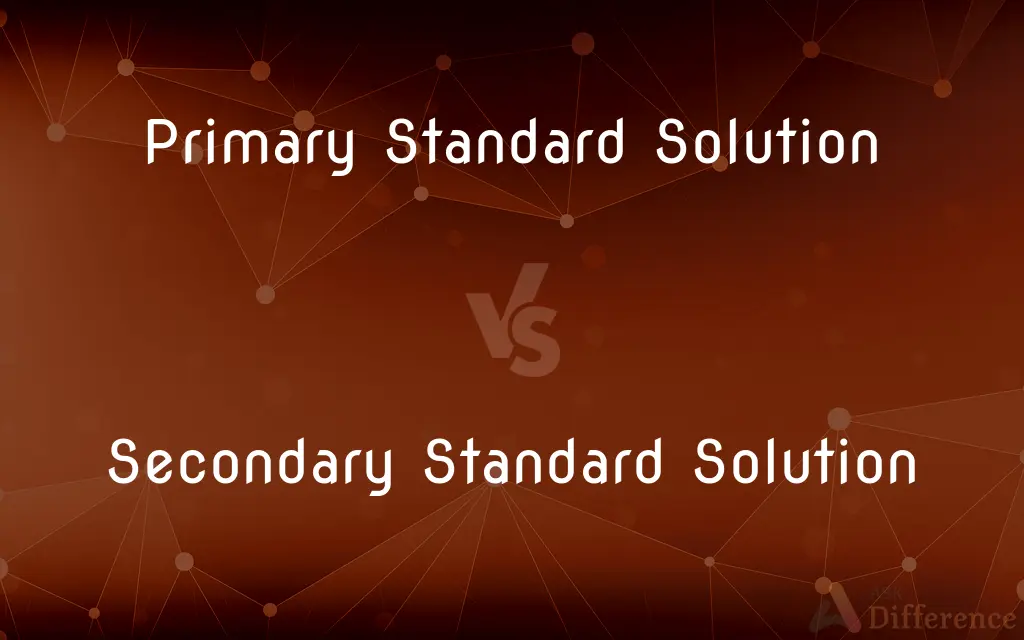Primary Standard Solution vs. Secondary Standard Solution — What's the Difference?
By Tayyaba Rehman — Published on October 31, 2023
Primary Standard Solution is a highly pure substance used to determine the concentration of other solutions, while Secondary Standard Solution is a solution whose concentration is determined using a primary standard.

Difference Between Primary Standard Solution and Secondary Standard Solution
Table of Contents
ADVERTISEMENT
Key Differences
In the realm of analytical chemistry, the Primary Standard Solution holds significant importance. This solution is derived from a substance of known purity and stability. It acts as a benchmark for the calibration of other solutions. On the other hand, a Secondary Standard Solution is typically prepared for routine laboratory analyses. It's a solution whose concentration is established by referencing a primary standard.
The Primary Standard Solution has unique attributes that set it apart. It must be highly pure, stable under storage, and unaffected by the atmosphere. Moreover, its molar mass should be high to minimize weighing errors. In contrast, the Secondary Standard Solution doesn't necessarily meet all these stringent criteria. Its primary objective is to serve regular laboratory tasks, making it more susceptible to degradation over time.
It's pivotal to recognize that while the Primary Standard Solution serves as a universal reference, not all substances can be primary standards due to stringent requirements. On the other spectrum, the Secondary Standard Solution is more flexible but needs frequent calibration against the primary standard to ensure its accuracy.
The procedures involving the Primary Standard Solution and Secondary Standard Solution are closely intertwined. To determine the concentration of an unknown solution, a chemist might use a secondary standard. However, the reliability of this method hinges on the secondary standard being calibrated using a primary standard beforehand.
In many laboratory setups, the Primary Standard Solution is used sparingly, primarily for calibrating secondary standards. This is due to the cost and effort associated with maintaining its high purity and stability. Meanwhile, the Secondary Standard Solution is more commonly used for regular titrations and analyses because of its convenience, even if it lacks the precision of its primary counterpart.
ADVERTISEMENT
Comparison Chart
Purity
Extremely pure.
Not as pure as primary standards.
Stability
Highly stable under storage and not reactive with the atmosphere.
Might degrade over time or under certain conditions.
Usage
Used to determine the concentration of other solutions.
Calibrated using a primary standard and then used for routine analyses.
Requirements
Must have a high molar mass and be resistant to atmospheric changes.
Doesn’t need to meet all stringent criteria of primary standards.
Frequency of Use
Used sparingly due to high purity and cost.
Commonly used in labs due to convenience, but needs frequent calibration.
Compare with Definitions
Primary Standard Solution
Highly stable and unaffected by the atmosphere.
The Primary Standard Solution remains consistent over time, ensuring accuracy in analyses.
Secondary Standard Solution
A solution whose concentration is established using a primary standard.
The Secondary Standard Solution was prepared and then calibrated against the primary standard.
Primary Standard Solution
Represents the gold standard in analytical chemistry.
For utmost precision, chemists often turn to the Primary Standard Solution.
Secondary Standard Solution
Relies on primary standards for accuracy.
To ensure its accuracy, the Secondary Standard Solution is periodically checked against a primary standard.
Primary Standard Solution
A benchmark solution in titrations.
A Primary Standard Solution provides a reference point to calibrate other solutions in the lab.
Secondary Standard Solution
Less pure than primary standards.
Over time, the Secondary Standard Solution might require recalibration due to potential degradation.
Primary Standard Solution
Used for calibrating secondary standards.
Before using a Secondary Standard Solution, it's calibrated against a known Primary Standard Solution.
Secondary Standard Solution
Provides convenience in regular analyses.
Using a Secondary Standard Solution can expedite routine lab work.
Primary Standard Solution
A solution of known concentration from a highly pure substance.
Potassium dichromate can be used as a Primary Standard Solution because of its purity and stability.
Secondary Standard Solution
Used for routine laboratory tasks.
For daily titrations, the lab generally employs a Secondary Standard Solution.
Common Curiosities
What's a Primary Standard Solution?
A Primary Standard Solution is derived from a substance of known purity and is used to determine the concentration of other solutions.
How is a Secondary Standard Solution different?
A Secondary Standard Solution is calibrated using a primary standard and is typically less pure, used for routine analyses.
Why is the molar mass of primary standards significant?
A higher molar mass in a Primary Standard Solution minimizes weighing errors.
Why isn't every substance a primary standard?
Not all substances meet the stringent requirements of purity, stability, and resistance to atmospheric changes of a Primary Standard Solution.
How often is the Primary Standard Solution used in labs?
A Primary Standard Solution is used sparingly due to its high purity and cost.
Can a Secondary Standard Solution degrade over time?
Yes, unlike a Primary Standard Solution, a Secondary Standard Solution might degrade or react under certain conditions.
Is cost a factor in choosing between these solutions?
Yes, due to its high purity, a Primary Standard Solution is typically more expensive than a Secondary Standard Solution.
What's the role of atmospheric changes in these solutions?
A Primary Standard Solution must resist atmospheric changes, while a Secondary Standard Solution might be more susceptible.
Can any solution be turned into a secondary standard?
Technically, any solution can be a Secondary Standard Solution as long as it's calibrated against a primary standard.
How often should a Secondary Standard Solution be calibrated?
A Secondary Standard Solution should be calibrated frequently against a primary standard to maintain accuracy.
Are there any risks in solely relying on secondary standards?
Solely using a Secondary Standard Solution without periodic calibration against a primary standard can lead to inaccuracies.
Are there specific examples of primary standards?
Yes, substances like potassium dichromate and sodium carbonate can serve as Primary Standard Solutions.
Why is purity essential for primary standards?
Purity ensures the consistency and reliability of a Primary Standard Solution as a reference.
What's the main application of these solutions?
Both types of solutions, especially the Primary Standard Solution, are vital in titrations and analytical chemistry.
How can one ensure the accuracy of a Secondary Standard Solution?
Regularly calibrate the Secondary Standard Solution against a known Primary Standard Solution.
Share Your Discovery

Previous Comparison
Body Mass vs. Body Weight
Next Comparison
Limit Order vs. Stop OrderAuthor Spotlight
Written by
Tayyaba RehmanTayyaba Rehman is a distinguished writer, currently serving as a primary contributor to askdifference.com. As a researcher in semantics and etymology, Tayyaba's passion for the complexity of languages and their distinctions has found a perfect home on the platform. Tayyaba delves into the intricacies of language, distinguishing between commonly confused words and phrases, thereby providing clarity for readers worldwide.














































